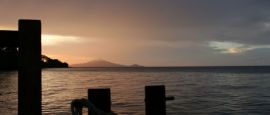Nicaragua Weather, climate and geography
Weather & climate
The climate in Nicaragua differs according to region, so the best time to go varies. The climate is tropical for almost the entire country and is therefore hot all year round, with temperatures averaging approximately 27ºC (81ºF) all year. In lower lying areas temperatures can range from 22ºC (72ºF) to 30ºC (86ºF), whilst in the mountains it is typically cooler; hovering between 12ºC (53ºF) and 20ºC (68ºF).
Most tourists visit Nicaragua during the dry season, which runs from December to May. The rainy season generally lasts from June to November, however nearer to the Pacific it runs from May to November. The climate on the Atlantic northwestern side of Nicaragua can be very temperamental and receives the highest volume of rainfall in the country on average.
Granada
The temperature in Granada varies little throughout the year, with the average high a balmy 32ºC (90ºF) and the average low a temperate 23ºC (74ºF). The best time to visit is in the dry season from early December to late March, when there is enough wind and breeze to cool the abrasive tropical heat.
León
Like much of Nicaragua, León is hot year round, and generally fluctuates between highs of 34ºC (94ºF) and lows of 23ºC (74ºF). Visiting León can be done year-round, however it’s recommended to visit during peak tourist season, particularly towards the start of the New Year. With high levels of humidity, as is typical of tropical Nicaragua, you’ll want to pack summer clothing and waterproofs too.
San Juan del Sur
A paradise for surfers and sunbathers, San Juan is perhaps where you’ll find Nicaragua at its most clement. With easy access to a number of beaches, the breeze here mitigates the searing heat of Nicaragua like no other, meaning you’ll be comfortable year-round.
Managua
The most built up of Nicaragua’s main cities, the capital experiences searing heat and humidity during the dry season and an abundance of tropical rain and grey skies during the wet season. With less trees and natural resources around in this metropolis, it’s harder to escape the full force of the elements, so planning accordingly is advised.
The peak tourist season in Nicaragua is between December and March, so anyone wanting to avoid the crowds should consider travelling during the shoulder season months of May and November.
Lightweight cottons and linens are required throughout the year – bring shorts, t-shirts, and beach wear if you’ll be visiting coastal regions. Waterproofs are advisable during the rainy season. Warmer clothes are recommended when visiting the northern mountains; think woolly knits and layers that allow you to wrap up warm as the temperature drops.
Geography
Nicaragua is the largest country in Central America, bordering Honduras to the north and Costa Rica to the south. To the east lies the Caribbean, and to the west the Pacific. In the north are the Isabella Mountains, while the country's main feature in the southwest is Lake Nicaragua which is about 160km (99 miles) long and about 72km (44 miles) at its widest. The island of Ometepe is the largest of the hundreds of islands on the lake. These islands have a reputation for great beauty and are one of the country's main tourist attractions.
Lake Managua is situated northwest of Lake Nicaragua. Volcanoes, including the famous Momotombo, protrude from the surrounding lowlands northwest of the lakes. The country's main rivers are the San Juan, the lower reaches of which form the border with Costa Rica, and the Rio Grande de Matagalpa. The Corn Islands (Islas del Maiz) in the Caribbean are two small beautiful islands fringed with white coral and palms. They are very popular as holiday resorts with both Nicaraguans and tourists.
Do you have any Feedback about this page?
© 2025 Columbus Travel Media Ltd. All rights reserved. No part of this site may be reproduced without our written permission, click here for information on Columbus Content Solutions.




 You know where
You know where